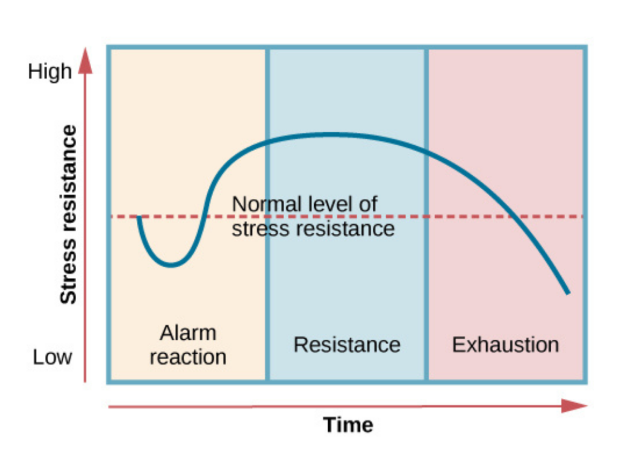Unit 4 - health psychology (psych)
1/19
Earn XP
Description and Tags
FINAL TOPIC! you got this, not long now - push through and achieve what i know you can :)
Name | Mastery | Learn | Test | Matching | Spaced |
|---|
No study sessions yet.
20 Terms
Stress
The non-specific response of the body to any demand
Demands can be psychological or physiological
To experience stress, a stressor must be present
Stress is experienced when a person perceives that the demand of the stressor exceed their ability to cope
Two types of stress (Selye, 1936)
Distress
Eustress
Distress (Two types of stress (Selye, 1936))
The negative psychological response to a stressor as indicated by the presence of negative psychological states
Impedes ability to perform at an optimal level
Can lead to health risks
e.g. death of a loved one, financial difficulties, conflict
Eustress (Two types of stress (Selye, 1936))
The positive psychological response to a stressor as indicated by the presence of positive psychological states
Occurs when when there is stress, yet a feeling of being capable to overcome
Increases alertness and energy levels, leading to optimum performance
It is normally enjoyable + can motivate behaviour
e.g. exam, graduating, driving test, starting a new job, interview, skydiving, etc
Stressor
Any person, object or event that challenges or threatens an individual, thus causing feelings of stress
*they are sources of stress
4 types of stressors (Selye, 1936)
Environmental stressors
Psychological stressors
Social stressors
Cultural stressors
Environmental stressors (4 types of stressors (Selye, 1936))
The conditions and physical surroundings of an individual
e.g. noise, temperature, smell, pollution, natural disasters, war, etc
Psychological stressors (4 types of stressors (Selye, 1936))
Caused by emotional and cognitive factors
e.g. graduating, new job, buying a house, pressure at work, driving test, etc
Social stressors (4 types of stressors (Selye, 1936))
Stems from relationships and interactions with society
e.g. peer pressure and conflict with family and friends
Cultural stressors (4 types of stressors (Selye, 1936))
Cultural identity, values and cultural norms
e.g. discrimination or loss of cultural practices
3 characteristics of stressors
Nature: types of stressors (4 types)
Duration: time frame - short term or long term
Strength: the severity/intensity of the stressor
Stress as a response
The General Adaptation Syndrome (GAS) model is used to describe the physiological changes that the body automatically goes through when it responds to stress.
2 physiological changes when exposed to a stressor and experience stress
Heart rate increases
Breathing rate increases
3 stages of the GAS model (Selye, 1936)
Alarm
Resistance
Exhaustion

Alarm - 3 stages of the GAS model (Selye, 1936)
This is an initial response to a stressor (4 types). The alarm stage has 2 substages
Shock: the body’s resistance drops below normal. It responds as if it has been injured
Countershock: the sympathetic NS activates to prepare for fight or flight
The amygdala detects threat and signals the hypothalamus = SNS
Triggers the release of adrenaline, noradrenaline and cortisol (stress hormones)
*countershock occurs 6-48 hours after initial stressor is detected
Resistance - 3 stages of the GAS model (Selye, 1936)
If the stressor remains, the body enters a resistance stage as it attempts to restabilise its internal systems and fight the stressor
The parasympathetic NS begins to counteract the heightened arousal
Stress hormones continue to be secreted to help the body cope
Energy is directed to managing the stress
Exhaustion - 3 stages of the GAS model (Selye, 1936)
Occurs if the stressor continues for a prolonged period
The body’s resources become depleted, leading to…
fatigue, low motivation, impaired immunity, and increased risk of mental illness and physical illness
The adrenal glands lose effectiveness, blood sugar drops and physical health declines
Stress as a stimulus
Holmes and Rahe (1967) described stress as a significant change in life that requires a response or adjustment to be made.
Social Readjustment Scale (SRS) - Holmes and Rahe, 1967
*also referred to as the Holmes and Rahe Stress Scale
Assesses amount of stress that has been experienced by an individual in the past year
Comprises of 43 life events - a score of 1 to 100 is allocated to each event
Score = life change unit (LCU). It estimates the amount of response and readjustment required if the event is experienced
Individual receives a score based on their total stress readjustment
Social Readjustment Scale (SRS) - Holmes and Rahe, 1967